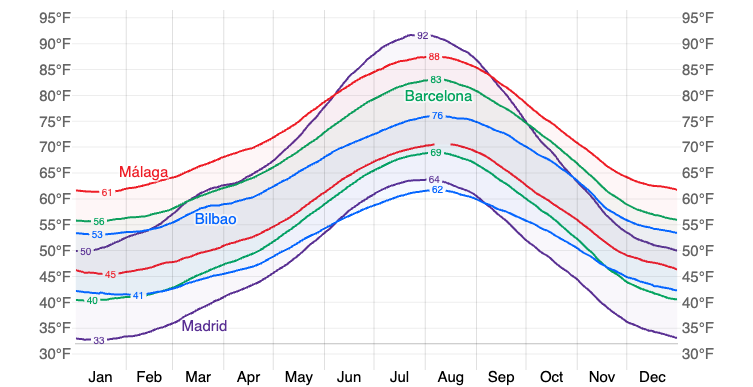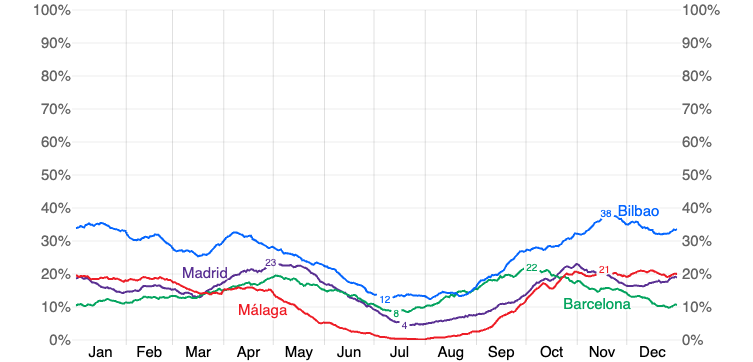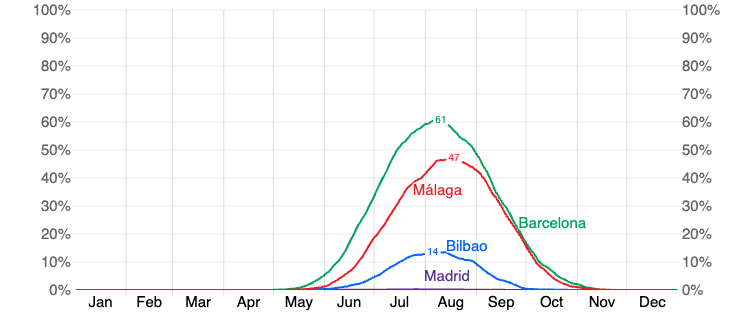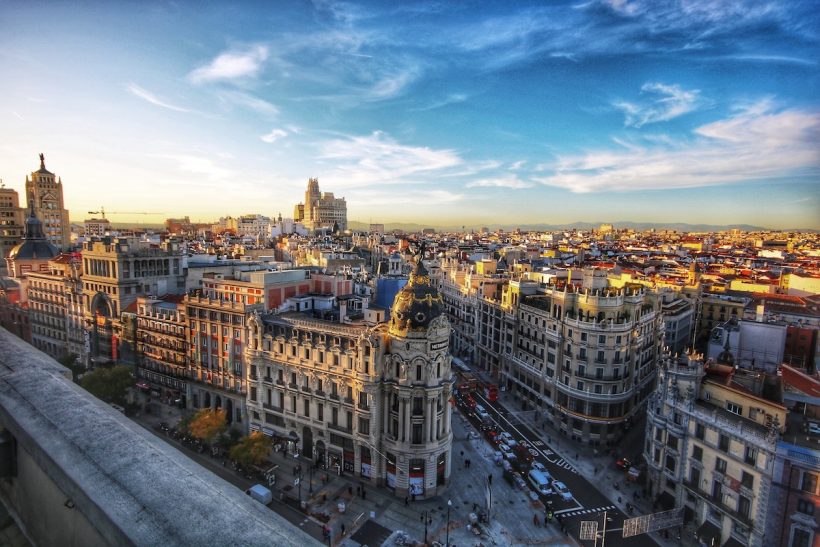Spain has something for everybody. From tasty food to stunning views and great nightlife, you rarely hear of a tourist leaving unimpressed. What’s more, is that the country as a whole gets fantastic weather most of the year. It’s seldom unreasonably hot, cold, or rainy!
However, with these lovely conditions comes massive crowds of tourists who want in on the action, too. The challenge becomes dodging crowds rather than heat or rain. When can one visit affordably visit and get nice weather at the same time? It can prove challenging, but it is surely possible.
The best months to visit Spain for the best combination of good weather and low prices are April or May. During these months, the country has warm temperatures all across the map. Prices are quite low, as in the off-season, and crowds are moderate!
What you want out of your trip also influences when you should go. Excited to spend time by the sea? The weather is fairly warm year-round but the water gets cold in winter! If you care more about sightseeing and history, the inland part of the country gets all the extremes: hot, dry summers and cold winters.
This article assesses the average weather and tourist season trends to determine the best month to visit Spain for good weather and low prices. To do this, we will look at four cities spread throughout the coastal region: Madrid, Barcelona, Málaga, and Bilbao. Additionally, we analyze tourism trends in these areas to determine how traffic reflects in pricing.
Table of Contents
Average Temperature In Spain
Like other Western European countries, the whole country enjoys warm temperatures for over half the year. Winters are bearable with a light jacket, as extreme temperatures are uncommon. Fall and spring are typically mild as well.
Madrid gets the hottest summers, capping at an average high of 91°F and low of 63°F in July. Málaga peaks a little later in August with highs of 87°F and lows of 70°F. Barcelona with its balmy Mediterranean climate, has milder summer heat that ranges from 68°F to 82°F in July and August, its hottest months. Bilbao is even cooler, maxing out at 76°F with 62°F lows in August.

Some cities cool off to nice, mild temperatures in the winter, but some get fairly cold. Madrid leads in both extremes. Though pushing over 90°F in the summer, January sees the city range from 33°F to 51°F throughout the day.
Bilbao is next in line with average January temps between 42°F and 53°F. Barcelona once again stays in the middle as it stays between 41°F and 56°F in the same month. Málaga, though hardly a beach destination in winter, is the warmest city of the season with highs of 61°F and lows of 46°F
Spring and autumn bring beautiful, warm temperatures to all four cities. Each of them gradually warms up and then cools down with no major differences.
Daily Chance Of Precipitation In Spain
The amount of precipitation varies drastically based on geography and season. Spain doesn’t get a ton of rain compared with some of its neighbors. However, some seasons have a higher chance of showers than others!
All four cities experience a relatively dry season that coincides with summer. July and August especially see a dropoff in precipitation. Bilbao, the wettest city in the group, only has a 12% chance of showers in July and August. Barcelona and Madrid have 8% and 4% chances, respectively. Beach paradise Málaga drops to a near-zero chance of wet weather at summer’s peak!

The wetter season runs from October through April. However, one should not expect daily torrential downpours Bilbao, in its heaviest month for rain, gets 10.7 wet days, equalling about 3.6 inches across the entire month.
Madrid has about 6 rainy days in April, May, and October, with 1 to 2 inches in each of the months. October is Barcelona’s rainiest month, with about 6 days and 2.4 inches. Málaga makes up for its rainless summers in November and December, also getting about 6 days each and a little over 2 inches of precipitation.
Humidity Comfort Levels In Spain
Though pretty warm most of the year, Spain isn’t always muggy! It has a clear humid weather season, and it coincides with summer. Picking up in May with the muggiest cities finally mellowing out in late October, summer can make for an uncomfortable visit. The humidity level depends heavily on geography, too. While it may feel awful in some cities, others are completely dry.

Madrid is one of the latter cities. Though it’s the hottest, it’s only dry heat! Bilbao is the next best spot for humidity haters, with only 3.8 muggy days in its worst month of August.
Málaga is considerably more humid than the first two. Almost half of the days in August are humid! Finally, Barcelona has the highest humidity in the summer. With over half of July and August having humid days, it can feel even hotter than in Madrid.
Best Time Of Year To Visit Spain For Great Weather
Spain has some of the most dependable weather in Western Europe. It has clear seasons of dry, wet, cold, and hot weather. Thanks to the relative uniformity of weather patterns across the country, it’s easy to plan a multi-city trip. Is there one perfect season to visit? Read and find out!
There are two factors used to decide the best months for weather called the “tourism score” and the “beach/pool score,” respectively. The first is used to determine how pleasurable outdoor activities like sightseeing tours are in a given month. Clear skies and temperatures between 65°F and 80°F are the criteria here.
Spain ranks highly on the tourism score from late spring through early autumn! Málaga is the highest scorer across the board with 8.3 in mid-June. The others aren’t far behind, though. Barcelona’s best time falls in the same period at 8.1 and Bilbao peaks in mid-July at 8.2. Madrid, due to its hotter summer temperatures, ranks a bit lower with a peak score of 7.5 in September once the heat subsides.
Málaga also shines brightest on the beach/pool score with 8.8 in July. Madrid’s high heat helps it here, as the city scores 8.6 at the same time! Barcelona is also great for a dip in the pool or sea with an 8.5 score in July.
Bilbao has cooler summers, making it less of an ideal swimming destination. In mid-July, it only has a 5.8 beach/pool score. Though not as comfortable as the other cities, it can still be a relaxing destination for water activities anyway!
Best Time Of Year To Visit Spain For Low Prices
In addition to its abundance of great weather, Spain can be an affordable destination if you book right! It’s considerably cheaper than its Western European neighbors, and deals are always around the corner. However, the season you visit impacts travel costs like airfare and accommodation rates.
Budget airlines like Ryanair and Wizzair have hundreds of connections to Spain from all over Europe. You can comfortably include a few Spanish cities in your European backpacking trip itinerary. Prices are typically low if you book early, even up to one month before the trip. Imagine flying to Madrid for just $10. Yes, it’s possible!
Unfortunately, these budget options don’t exist for those traveling overseas. However, deals still exist! The season you fly impacts the price greatly.
Trans-Atlantic prices skyrocket when American schools are let out for vacation. Expect to pay no less than $500 from June to August. It can even jump over $700 for round-trip flights.
Traveling in the off-season in winter can help you secure a cheaper flight. Round-trip journeys in January and February can run you only $350 if you book at the right time! If you’re a serious deal hunter, you can even find off-season trips for $150 if you’re persistent!
As with flights, room prices go up in the summer and around special events and holidays. Mid-range hotels cost about $90 per night in the low and off-season, and can sometimes double in the summer!
Peak Travel Season In Spain
Spain’s peak season of June to August is a period of highs: the highest temperatures, the highest tourist population, and the highest prices! Tourist attractions and the seaside will be packed with people from all over.
The weather is some of the best all year. Don’t count on rain ruining your plans. The heat might be too much for some, but there are places to cool off in every city.
Spanish summer festivals bring in massive international crowds and often take place in cities, leading to shortages of rooms. Watch out for Barcelona’s Primavera Sound and Madrid’s Mad Cool music festivals, as you’ll face stiff competition for accommodations.
For peak season, a good deal on a budget flight might rise to $75 or $100. If traveling from North America, you’ll likely pay $700 or more.
Accommodations disappear in coastal areas like Málaga in August as Spaniards go on vacation. If you can find a room available for this period, expect to pay no less than $175 per night. You might have better luck finding a cheaper room in an inland city like Madrid, as they are often empty at this time.
Shoulder Travel Season In Spain
Spain’s shoulder seasons are shrinking with more budget flight routes opening up on the peripheries of peak season every year. Traditionally, these months coincided with spring and autumn. Potential tourists want to take advantage of the deals and good weather. Plenty of deals exist, but people planning a shoulder season visit shouldn’t linger lest they get snatched up by fellow bargain hunters.
The autumn months September and October are still very warm across the country. However, the later in the season you visit, the greater your chances of getting wet become! Most of the cities discussed in this article have their wettest weather from late September through the next month. Spring months March through May also have the potential for rain, but it’s considerably lower than in the autumn.
Flight and accommodation prices don’t fluctuate much between the shoulder and off seasons. Whether traveling in January or October, a room in a mid-range hotel costs $90 on average. However, different properties change their prices all the time, so be vigilant for discounts! You can find good flight prices from the USA ranging from $350 to $550.
Though previously mentioned as part of peak season, August is another shoulder season for non-coastal areas. Schools and offices are both on vacation, and families escape the worst of the summer heat by going abroad or heading to the seaside. Prices might stay at peak season level but expect smaller crowds in cities like Madrid or Granada.
Low Travel Season In Spain
Spain’s off-season runs from late November through February and sees the lowest tourist numbers on average. As in shoulder season, you’ll find cheaper flights from North America than in summer. Furthermore, accommodations are reasonably priced throughout this period.
Temperatures in inland cities like Madrid can get rather cold. However, it depends on your preferences. If cold weather doesn’t bother you, you’ll enjoy a quiet walk around the city, taking in the sights with fewer people in your way.
Expect resort areas like Málaga to be largely empty. Coastal cities with points of interest like Barcelona and Bilbao are great to visit at this time. Their temperatures feel almost spring-like and they have the lowest crowds of any season. Imagine seeing La Sagrada Familia without having to wait in line for over an hour!
The threat of precipitation goes up in winter, especially in Bilbao. However, the amount of rainfall isn’t too high. Pack an umbrella or raincoat and you’re all set. Those visiting in late November and December will witness Spain’s Christmas markets. This presents a unique chance to try delicious seasonal foods and take home traditional crafts that few other foreign guests will ever see.
Best Months For Travel To Spain
There’s hardly a bad time to visit Spain. The Iberian Peninsula is blessed with good weather all over, almost all the time. Each season comes with a plethora of opportunities for visitors to make their dream vacation come true. The best time to visit depends largely on what type of tourist you are.
Looking to kick back and relax by the beach or pool? Summertime is your best bet. The coast is relatively cool in the summer, so the water will be warmest then.
If your goal is to sightsee and take in the country’s rich history and cultural heritage, you have more flexibility. Winter months like January and February, though chilly, rarely have freezing temperatures. You can save and beat crowds visiting then.
However, for the best combination of good weather and low prices, consider traveling to Spain in April or May. During these months, the country has warm temperatures all across the map. Prices are quite low, as in the off-season, and crowds are moderate!




